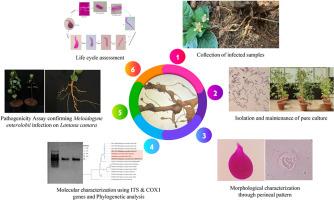Pathogenic interaction and molecular characterization of Meloidogyne enterolobii infecting Lantana camara: A new host association from India
IF 3.3
3区 农林科学
Q2 PLANT SCIENCES
引用次数: 0
Abstract
Lantana camara L., a widely distributed perennial shrub in India, is often recognized for its invasive potential and reported nematicidal properties. Paradoxically, during a survey in guava orchards of Karnataka, India, extensive root galling was observed on L. camara plants growing as hedge borders. This study was undertaken to investigate the causal organism and assess its pathogenic potential. Nematodes isolated from the infected roots were purified and identified as Meloidogyne enterolobii based on detailed morphological and morphometric characteristics of second-stage juveniles, males, females, and perineal patterns. Molecular confirmation was achieved through PCR amplification of the ITS rDNA and COX1 regions, along with species-specific SCAR primers, which yielded a 520 bp product specific to M. enterolobii; no amplification occurred with M. incognita-specific primers. BLASTn analysis of ITS and COX1 sequences showed 100 percent identity with reference M. enterolobii sequences, and phylogenetic analysis clustered the isolates within the M. enterolobii clade. Pathogenicity was confirmed via pot experiments, wherein L. camara plants inoculated with two isolates (ChMe1 Bengaluru and ChMe2 Kolar) developed characteristic galls and egg masses: ChMe1 produced 79.8 ± 7.16 galls and 71.2 ± 6.72 egg masses, while ChMe2 yielded 99.6 ± 12.60 galls and 86.0 ± 8.94 egg masses (mean ± SD, n = 5). The nematode completed its life cycle in 30–35 days, and its identity was reconfirmed from re-isolated specimens, fulfilling Koch's postulates. This study provides the first report of M. enterolobii infecting L. camara from India, a plant previously regarded as nematode-suppressive. The results underscore the potential of invasive perennial weeds like L. camara to act as alternate or reservoir hosts for aggressive nematodes, complicating nematode management in adjoining crops such as guava. The study highlights the importance of including such weeds in integrated nematode management strategies to limit inoculum buildup and pathogen persistence in agroecosystems.

一种来自印度的新寄主联系体——小绒猴感染的致病相互作用和分子特征
印度的一种广泛分布的多年生灌木,常被认为具有入侵潜力和报道的杀线虫特性。矛盾的是,在印度卡纳塔克邦番石榴果园的一项调查中,在作为树篱边界生长的L. camara植物上观察到广泛的根瘤。本研究的目的是调查病原菌并评估其致病潜力。从受感染的根中分离的线虫经过纯化,并根据其第二阶段幼虫、雄性、雌性和会阴模式的详细形态特征和形态计量学特征鉴定为肠柔根线虫。通过ITS rDNA和COX1区域的PCR扩增以及物种特异性SCAR引物,获得了520 bp的肠芽孢杆菌特异性产物,从而获得了分子确认;用M. incognita特异性引物未发生扩增。BLASTn分析显示ITS和COX1序列与参考肠肠杆菌序列100%一致,系统发育分析将分离株聚集在肠肠杆菌分支中。菌株ChMe1 Bengaluru和ChMe2 Kolar分别接种后产生特化虫瘿和卵团,其中ChMe1产79.8±7.16个虫瘿和71.2±6.72个虫卵团,ChMe2产99.6±12.60个虫瘿和86.0±8.94个虫卵团(mean±SD, n = 5)。该线虫在30-35天内完成了其生命周期,并从重新分离的标本中重新确认了其身份,符合Koch的假设。该研究首次报道了肠弧菌感染印度的L. camara,一种以前被认为具有线虫抑制作用的植物。这些结果强调了像L. camara这样的多年生入侵杂草作为侵略性线虫的替代宿主或储存库的潜力,使番石榴等邻近作物的线虫管理复杂化。该研究强调了将这些杂草纳入综合线虫管理策略的重要性,以限制农业生态系统中接种量的积累和病原体的持久性。
本文章由计算机程序翻译,如有差异,请以英文原文为准。
求助全文
约1分钟内获得全文
求助全文
来源期刊
CiteScore
4.30
自引率
7.40%
发文量
130
审稿时长
38 days
期刊介绍:
Physiological and Molecular Plant Pathology provides an International forum for original research papers, reviews, and commentaries on all aspects of the molecular biology, biochemistry, physiology, histology and cytology, genetics and evolution of plant-microbe interactions.
Papers on all kinds of infective pathogen, including viruses, prokaryotes, fungi, and nematodes, as well as mutualistic organisms such as Rhizobium and mycorrhyzal fungi, are acceptable as long as they have a bearing on the interaction between pathogen and plant.

 求助内容:
求助内容: 应助结果提醒方式:
应助结果提醒方式:


